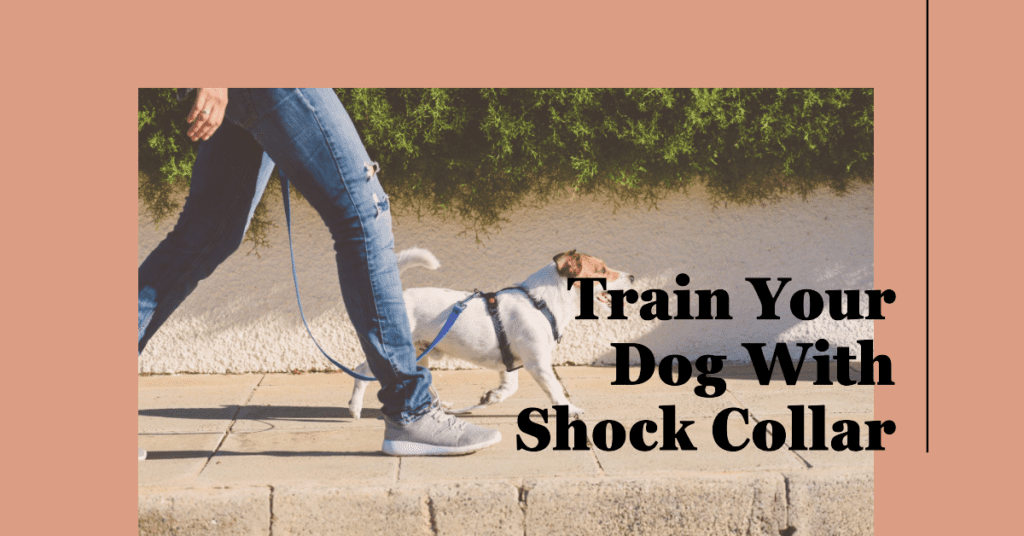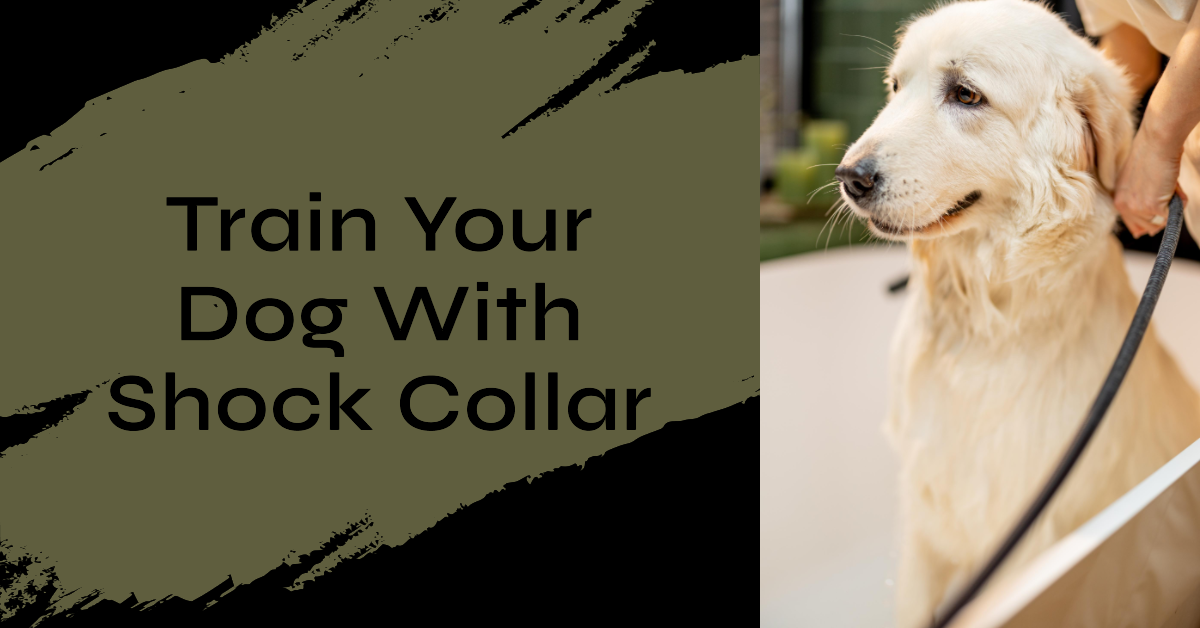Training a dog can be a challenging and time-consuming task, but with the help of modern technologies such as shock collars, the process can become more efficient. Shock collars are controversial training tools that deliver an electric stimulus to the dog's neck when it exhibits undesirable behavior. While some believe that shock collars can be harsh and inhumane, others argue that they are effective and humane when used correctly. So, how long does it take to train a dog with a shock collar?
To get a better understanding of this, we turned to dog training experts for their insights. According to experts, the time it takes to train a dog with a shock collar can vary significantly depending on various factors. These include the dog's temperament, age, previous training, and the consistency and effort put into the training by the owner.
In general, training with a shock collar takes a few weeks to several months for the dog to learn and understand the desired behaviors. However, it is important to note that shock collars should always be used as a last resort and under the guidance of a professional dog trainer to ensure the safety and well-being of your furry friend.
Timeline for shock collar training
This table provides a structured timeline for using a shock collar in dog training, emphasizing the importance of gradual training and transitioning to positive reinforcement methods over time.
| Timeline Stage | Duration | Activities and Training Goals |
|---|---|---|
| Initial Introduction | Day 1-2 | – Introduce the dog to the collar without shocks. |
| – Allow the dog to get accustomed to wearing the collar. | ||
| – Associate the collar with positive experiences. | ||
| Basic Training | Days 3-7 | – Start basic command training (e.g., sit, stay) with collar. |
| – Use the lowest stimulation level for command association. | ||
| Adjustment Period | Weeks 2-4 | – Gradually increase stimulation as needed for responsiveness. |
| – Monitor and adjust according to the dog's behavior. | ||
| Reinforcement and Advanced | Weeks 5-8 | – Use the collar to reinforce commands and advanced training. |
| – Maintain consistency and positive reinforcement. | ||
| Ongoing Training | Months 2+ | – Regular training sessions with the shock collar as needed. |
| Assessment | Months 3-6 | – Evaluate the dog's progress and behavior. |
| – Gradually reduce reliance on the shock collar. | ||
| Transition to Positive | Months 6+ | – Phase out shock collar, shift to positive reinforcement. |
| Reinforcement | – Continue reinforcing good behavior with rewards and praise. |
Shock collars and their use in dog training
Shock collars, also known as electronic collars or e-collars, are devices used in dog training to deliver an electric shock to the dog's neck. They are often used as a form of punishment or aversive training. The collar contains a small box with metal prongs that make contact with the dog's skin. When a button is pressed on a remote control, a current is sent through the prongs, causing a shock. The level of shock can typically be adjusted according to the trainer's preference.
Proponents of shock collars argue that they can be effective in correcting unwanted behaviors such as excessive barking, aggression, or disobedience. However, critics say that using shock collars can cause fear, anxiety, aggression in dogs, and physical harm. They believe that positive reinforcement methods, such as rewards and praise, are more humane and effective in training dogs.


How Long Does It Take to Train a Dog with a Shock Collar
Understanding the timeline for shock collars to work effectively is crucial in training dogs. Dogs need to associate the shock with the undesired behavior, and a delay in the application of the shock can lead to confusion and ineffective training. For example, if a dog barks excessively and the shock is applied several seconds later, the dog may not understand why it is being shocked. This can result in the dog associating the shock with something else entirely, making the training ineffective.
Additionally, using shock collars in conjunction with positive reinforcement can be highly effective. By rewarding desired behaviors immediately after using the shock collar, dogs are more likely to understand the association between the shock and the correction. Therefore, understanding the timeline for shock collars is crucial for their proper usage and effectiveness in dog training.
Variables Influencing Dog Training Collar
There are several variables that can influence the time frame of training with a shock collar. The first variable is the individual dog's temperament and sensitivity to the collar. Some dogs may respond quickly to the correction, while others may require more time to understand and learn from the stimulation. The second variable is the training consistency and methodology used by the owner. Effective training requires consistency and clear communication. If the owner is inconsistent in using the shock collar or fails to provide proper guidance, it will prolong the training process. Additionally, the complexity of the behaviors being trained and the frequency of training sessions can also impact the time frame.
Dog's temperament and personality
The temperament and personality of a dog can vary greatly depending on factors such as breed, upbringing, and individual experiences. Some dogs may naturally be more outgoing and friendly, while others may be more reserved and cautious. Training plays a crucial role in shaping a dog's temperament and behavior. Dog training helps establish boundaries, build trust, and enhance communication between a dog and its owner.
While a shock collar may expedite the training process, it is essential to prioritize positive reinforcement techniques and create a safe and loving environment for the dog.
Breed and size of the dog
The breed and size of the dog can have a significant impact on training with a shock collar. Smaller breeds may be more sensitive to the shock and may need a lower level of intensity, while larger breeds may require a higher level to feel the effects. Additionally, certain breeds are known for their stubbornness, which can affect how effective the shock collar is during training.
It is important to choose the right size and intensity of the training collar to ensure it is appropriate for the dog's specific breed and size. Furthermore, the time it takes to train a dog using a shock collar can vary depending on the individual dog and their response to the training method.
Consistency and frequency of training sessions
The consistency and frequency of training sessions have a significant impact on the effectiveness of shock collar training. Shock collars are often used to curb unwanted behaviors, such as excessive barking, in dogs. However, it is crucial to remember that a dog with a shock collar is still a living being and should be treated with care and respect.
Consistent and regular use of the training device can help reinforce desired behaviors and discourage unwanted ones. Training sessions should be conducted for an appropriate duration, ensuring that the dog is old enough for a shock collar. The length of training varies depending on the dog and the level of behavior modification required. Overall, the commitment and efforts put into training a dog with a shock collar directly impact the success and overall well-being of the dog.
Trainer's experience and techniques used
The experience and techniques used by a trainer can greatly impact the effectiveness of shock collar training. It is important to assess whether a dog is old enough for a shock collar and whether their behavior warrants its use. Training with an electronic dog collar requires a skilled trainer who knows how to properly introduce and use the collar.
It is crucial to find a balance between utilizing the shock function and other positive reinforcement techniques to effectively train a dog. A trainer's experience and knowledge of collar work can determine the success of shock collar training and ensure the well-being of the dog during the training process.
Train Your Dog – Tips for Successful Training Dog with a Shock Collar
Training a dog can be a challenging task, but with the right tools and techniques, it can be a rewarding experience for both you and your furry friend. One popular training tool that has gained some controversy is the shock collar. Let's explore the use of shock collars in dog training and some tips for successful training with this device.
Understanding the importance of positive reinforcement
Understanding the importance of positive reinforcement in dog training is crucial when it comes to using a shock collar. However, relying solely on shock collars can have negative consequences and may harm the dog physically and mentally. It is essential to consider the duration of training when using a dog with a shock collar.
While some dogs may respond quickly, others may take longer to train. Therefore, it is important to be patient and consistent in order to effectively train your dog. Ultimately, the best approach to training is to combine positive reinforcement techniques with the use of a shock collar, ensuring the dog understands desired behaviors while maintaining their well-being and happiness.
Consistency in commands and training sessions
Consistency is essential when using a shock collar on a puppy during dog training sessions. It is important to teach your dog that certain behaviors are unacceptable and the collar delivers a mild shock to discourage them. By using the shock collar consistently, the puppy will understand the consequences of their actions.
However, it is crucial to remember that the shock should never be excessive or used as a means of punishment. A well-trained dog should associate the shock collar with specific commands and use it as a tool for reinforcement. Consulting with a professional dog trainer can provide valuable guidance on how to safely and effectively use a shock collar in training.
Gradual increase in the level of shock intensity
When using a gradual increase in the level of shock intensity for dog training, it is crucial to enlist the help of a professional dog trainer. Dog owners should never attempt this training method without guidance from an expert. During a training session, the professional dog trainer will use a training device such as a shock collar to administer a mild electric shock to the dog. The shock intensity will be increased gradually, ensuring that it is within the dog's comfort level. This method should always be coupled with positive reinforcement to encourage desired behaviors. With proper guidance and positive reinforcement, shock collar training can be an effective tool for training your dog.
Regular assessments of the dog's progress
Regular assessments of a dog's training progress are essential to ensure that the training is effective and on track. These assessments help to identify any areas where the dog may be struggling or not fully understanding the commands. By evaluating the dog's progress on a regular basis, the trainer can make necessary adjustments to the training plan and techniques.
This allows for a more efficient training process and helps the dog to learn and retain commands more effectively. Regular assessments also provide an opportunity to celebrate the dog's achievements and motivate both the dog and the trainer to continue with their training journey.
Common Challenges and Troubleshooting
| Setback or Difficulty | Description | Strategies to Address |
|---|---|---|
| Inconsistent Use | Inconsistent use of the shock collar can confuse the dog and hinder learning. | Ensure all handlers are trained in proper collar use and commands. Establish a consistent training schedule. |
| Overuse or High Stimulation Levels | Excessive use or high stimulation levels can lead to stress, fear, or even physical harm to the dog. | Carefully follow manufacturer guidelines for stimulation levels. Use the lowest effective setting. |
| Lack of Proper Training | Improper training techniques or reliance solely on the collar without positive reinforcement can be counterproductive. | Seek guidance from a professional dog trainer for proper training methods. Incorporate positive reinforcement alongside collar use. |
| Misunderstanding of Commands | The dog may not understand the connection between collar stimulation and specific commands. | Ensure clear and consistent command signals and pair them with collar stimulation appropriately. |
| Negative Emotional Associations | The dog may develop negative associations with the training process or training area. | Use the collar in a positive and controlled environment. Gradually introduce the collar to prevent fear or anxiety. |
| Aggressive Behavior | Some dogs may become aggressive or fearful in response to the shock collar. | If aggression arises, discontinue collar use and consult a professional trainer for behavior modification techniques. |
| Lack of Individual Adaptation | Not all dogs respond the same way to shock collar training; some may require alternative training methods. | Recognize when the collar is not suitable for a specific dog and explore alternative training techniques, such as positive reinforcement. |
| Limited Training Scope | Shock collars are not suitable for all types of training, and relying solely on them may neglect other essential aspects of a dog's development. | Combine shock collar training with broader training strategies to address all aspects of a dog's behavior and well-being. |
| Equipment Malfunction | Collar malfunction or failure can disrupt training sessions and cause confusion for the dog. | Regularly check and maintain the shock collar, including batteries and connections, and have a backup collar on hand. |
Best dog training collar
Last update on 2025-06-15 / Affiliate links / Images from Amazon Product Advertising API
Conclusion
In conclusion, the use of a shock collar as a training method for dogs should be approached with caution. While it may seem like a quick and easy solution, the potential negative effects on the dog's well-being and behavior should not be overlooked. The time it takes to train a dog with a shock collar may vary depending on several factors, including the dog's breed, age, temperament, and previous training experiences. However, it is important to consider alternative training methods that focus on positive reinforcement and building a trusting bond with the dog. These methods may take more time and effort but ultimately result in a happier, well-behaved dog.
FAQs – How Long Does It Take to Train a Dog with a Shock Collar?
Training a dog with a shock collar can vary depending on several factors. Here are some key points to consider:
How does a shock collar work?
A shock collar is an electronic training device that delivers a mild electric shock to the dog's neck. This serves as a deterrent to unwanted behaviors and helps reinforce positive behaviors through negative reinforcement.
How long does it take to train a dog with a shock collar?
The duration of training with a shock collar can vary greatly depending on the dog's temperament, the specific behavior you are trying to address, and your consistency in using the collar. Some dogs may respond quickly within a few days, while others may require several weeks or even months of consistent training.
Is my dog old enough for a shock collar?
It is generally recommended to wait until a dog is at least 6 months old before introducing a shock collar. This allows the dog to mature physically and mentally, making them better able to understand and respond to the training.
Can a shock collar help with all types of behavior issues?
A shock collar can be a helpful tool for addressing a wide range of behavior issues, including excessive barking, leash pulling, and aggression. However, it is important to consult with a professional dog trainer to determine if a shock collar is appropriate for your dog's specific behavior issues.
What is the best dog training collar?
There are many dog training collars available in the market, such as the Halo Collar and modern shock collars. The best dog training collar for you will depend on your dog's specific needs and the training methods you prefer. It is always recommended to choose a high-quality collar from a reputable brand.
Can a shock collar work for training hunting dogs?
Yes, shock collars can be effective for training hunting dogs. They can be used to reinforce commands, control distance, and discourage unwanted behaviors that may hinder the dog's performance in the field. However, it is important to use the collar responsibly and under the guidance of a professional trainer.
Can a shock collar be used on stubborn dogs?
Yes, shock collars can be used on stubborn dogs. However, it is essential to use them as part of a comprehensive training program that includes positive reinforcement and consistent training sessions. It is always recommended to consult with a professional.















